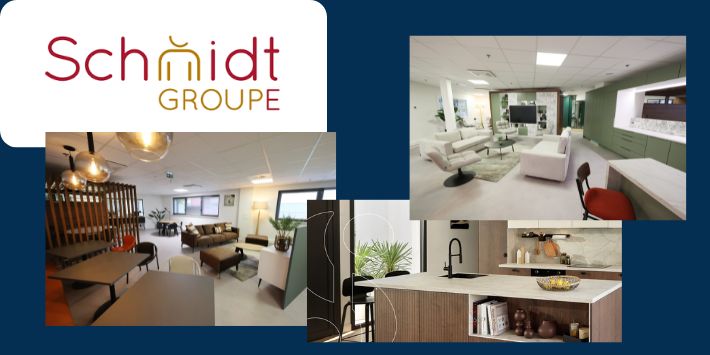SCHMIDT involves its suppliers in its low-carbon strategy
The Schmidt Group has chosen GCI to assess the carbon footprint of its activities, as part of its commitment to business ethics and sustainability, and its goal of carbon neutrality by 2030.

Group creation date
Schmidt Group employees
kitchen components manufactured every day
The GCI solution was exactly what we needed.
Context
In 2021, the Schmidt Group carried out a GHG balance based on 2019 data (2020 being Covid's year...), using average emission factors from ADEME. The inaccuracy of this assessment was between 50% and 80%.
Schmidt wanted to achieve several things:
- Improve the accuracy of your balance sheet.
- In particular, to improve the accuracy of Scope 3, which accounts for the bulk of its emissions (99.4%)
- Motivate your in-house purchasing team to collect accurate data.
- Involve suppliers in the process, the majority of whom are SMEs and very small businesses, i.e. companies with little experience of carbon issues.
- Compare carbon footprints and track emissions.
- Guide the group's future choices based on the results.
What's more, the Schmidt Group has always been keen to be a forerunner rather than a follower when it comes to environmental issues. Its B Corp certification attests to its commitment to business ethics and sustainability, just as its goal of carbon neutrality by 2030 attests to its proactivity. The careful verification of Purchases made according to their labels, and the and the promotion of Responsible Purchasing are part of these objectives.
To give concrete expression to its commitments, the group has chosen an innovative partner , specialized in decarbonizing Purchasing, with a collaborative solution : GCI.
Company presentation
The Schmidt Group is France's leading manufacturer of made-to-measure kitchens, storage units and bathrooms.
Their raison d'être: "Creating sustainable, inspiring and inspired living spaces!"

Why choose GCI?
GCI is a precise tool, based on internationally recognized, compliant and constantly updated methods and databases. The emission factors used are accurate.
It's also a tool with an innovative educational approach. It is designed to empower partners and encourage them to integrate decarbonization issues into their strategy, by teaching them to draw up their own Product Carbon Footprint ( PCF ).
This is achieved by providing explanations, tutorials and videos (GCI Academy) to help users navigate the tool, which is educational, easy to learn and use, with support available in the event of problems. Our in-house teams and suppliers easily got to grips with the tool, and quickly developed their skills .
For some suppliers, it was a revolution: not all have the same level of maturity on the subject, and the tool enables us to raise their awareness and support them in their approach .
A major advantage of GCI is the free access to the platform for suppliers. Supplier commitment is a real challenge for a low-carbon corporate strategy. The fact that GCI is free of charge for suppliers ensures maximum commitment. The Schmidt Group was able to sign up 80% of its suppliers (in terms of financial volume).
What are the results of your collaboration with GCI?
All the group's objectives were achieved, and more!
Firstly, the use of GCI has enabled a significant reduction in the uncertainty of the GHG Balance, particularly for scope 3, from 50% to 5%. The Group now has 95% accurate data.
Thanks to supplier data collected and interpreted by the GCI tool, in-depth in-house analyses have been carried out on the impact of 35,000 products, grouping suppliers into 170 families. This represents +80% of purchases in mass and in euros.
The tool enabled very precise tracking and combined with the Group's reporting tool, a rapid view of carbon impacts by supplier, product and material. This facilitated the development of a more effective and visual action plan, as well as supplier engagement by showing them directly the impact of their products - and where they came from.
The intelligent use of GCI has turned it into a decision-making tool, and is helping the group to think in "carbon" terms for years to come.
Finally, thanks to the possibility of breaking down the product, the group was able to notice the impact of certain materials in certain products and identify substitutes.
For example, he realized the impact of polypropylene in the garbage cans produced - 93 tonnes of carbon/year - and after discussions with the supplier in question, was able to switch to recycled polypropylene, which has a lower impact.
This was followed by similar discussions with other suppliers, all of whom agreed to switch to recycled material. As a result, a saving of 242 tonnes of CO2 per year has been calculated for the new 2024/26 product range.
This makes GCI a real lever for the eco-design of the Group's products.
What are GCI's "plusses"?
The excellent follow-up, the ability to run simulations of our balances, to break down the carbon impact of items, and to connect GCI results with different information systems: Purchasing IS, ERP, Business Intelligence.






